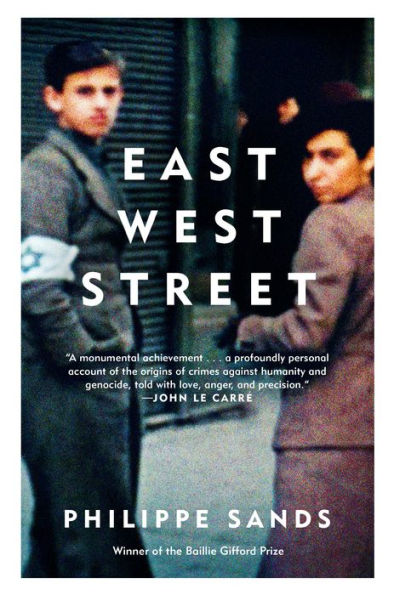East West Street: On the Origins of "Genocide" and "Crimes Against Humanity"
A profound, important book, a moving personal detective story and an uncovering of secret pasts, set in Europe’s center, the city of bright colors—Lviv, Ukraine, dividing east from west, north from south, in what had been the Austro-Hungarian Empire.
A book that explores the development of the world-changing legal concepts of “genocide” and “crimes against humanity” that came about as a result of the unprecedented atrocities of Hitler’s Third Reich.
It is also a spellbinding family memoir, as the author traces the mysterious story of his grandfather as he maneuvered through Europe in the face of Nazi atrocities. This is “a monumental achievement ... told with love, anger and precision” (John le Carré, acclaimed internationally bestselling author).
East West Street looks at the personal and intellectual evolution of the two men who simultaneously originated the ideas of “genocide” and “crimes against humanity,” both of whom, not knowing the other, studied at the same university with the same professors, in “the Paris of Ukraine,” a major cultural center of Europe, a city variously called Lemberg, Lwów, Lvov, or Lviv.
Phillipe Sands changes the way we look at the world, at our understanding of history and how civilization has tried to cope with mass murder
1122713497
A book that explores the development of the world-changing legal concepts of “genocide” and “crimes against humanity” that came about as a result of the unprecedented atrocities of Hitler’s Third Reich.
It is also a spellbinding family memoir, as the author traces the mysterious story of his grandfather as he maneuvered through Europe in the face of Nazi atrocities. This is “a monumental achievement ... told with love, anger and precision” (John le Carré, acclaimed internationally bestselling author).
East West Street looks at the personal and intellectual evolution of the two men who simultaneously originated the ideas of “genocide” and “crimes against humanity,” both of whom, not knowing the other, studied at the same university with the same professors, in “the Paris of Ukraine,” a major cultural center of Europe, a city variously called Lemberg, Lwów, Lvov, or Lviv.
Phillipe Sands changes the way we look at the world, at our understanding of history and how civilization has tried to cope with mass murder
East West Street: On the Origins of "Genocide" and "Crimes Against Humanity"
A profound, important book, a moving personal detective story and an uncovering of secret pasts, set in Europe’s center, the city of bright colors—Lviv, Ukraine, dividing east from west, north from south, in what had been the Austro-Hungarian Empire.
A book that explores the development of the world-changing legal concepts of “genocide” and “crimes against humanity” that came about as a result of the unprecedented atrocities of Hitler’s Third Reich.
It is also a spellbinding family memoir, as the author traces the mysterious story of his grandfather as he maneuvered through Europe in the face of Nazi atrocities. This is “a monumental achievement ... told with love, anger and precision” (John le Carré, acclaimed internationally bestselling author).
East West Street looks at the personal and intellectual evolution of the two men who simultaneously originated the ideas of “genocide” and “crimes against humanity,” both of whom, not knowing the other, studied at the same university with the same professors, in “the Paris of Ukraine,” a major cultural center of Europe, a city variously called Lemberg, Lwów, Lvov, or Lviv.
Phillipe Sands changes the way we look at the world, at our understanding of history and how civilization has tried to cope with mass murder
A book that explores the development of the world-changing legal concepts of “genocide” and “crimes against humanity” that came about as a result of the unprecedented atrocities of Hitler’s Third Reich.
It is also a spellbinding family memoir, as the author traces the mysterious story of his grandfather as he maneuvered through Europe in the face of Nazi atrocities. This is “a monumental achievement ... told with love, anger and precision” (John le Carré, acclaimed internationally bestselling author).
East West Street looks at the personal and intellectual evolution of the two men who simultaneously originated the ideas of “genocide” and “crimes against humanity,” both of whom, not knowing the other, studied at the same university with the same professors, in “the Paris of Ukraine,” a major cultural center of Europe, a city variously called Lemberg, Lwów, Lvov, or Lviv.
Phillipe Sands changes the way we look at the world, at our understanding of history and how civilization has tried to cope with mass murder
20.0
In Stock
5
1

East West Street: On the Origins of "Genocide" and "Crimes Against Humanity"
464
East West Street: On the Origins of "Genocide" and "Crimes Against Humanity"
464Paperback(Reprint)
$20.00
20.0
In Stock

Product Details
| ISBN-13: | 9780525433729 |
|---|---|
| Publisher: | Knopf Doubleday Publishing Group |
| Publication date: | 07/11/2017 |
| Edition description: | Reprint |
| Pages: | 464 |
| Sales rank: | 133,815 |
| Product dimensions: | 6.10(w) x 9.10(h) x 1.00(d) |
About the Author
From the B&N Reads Blog
